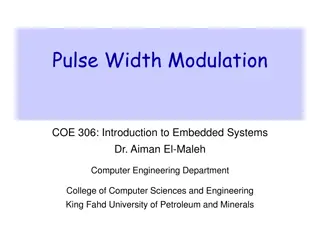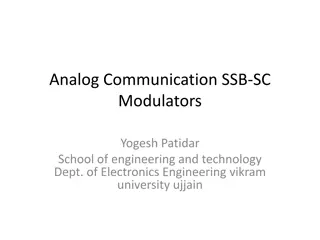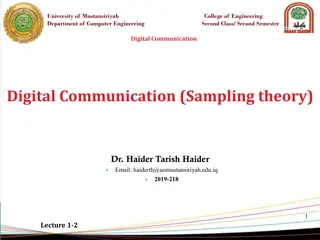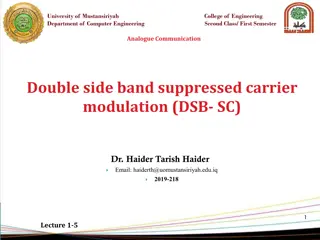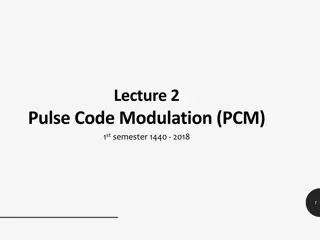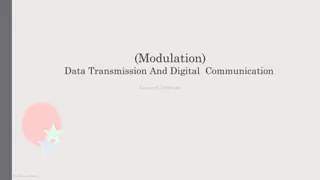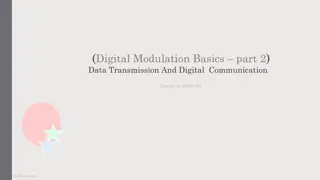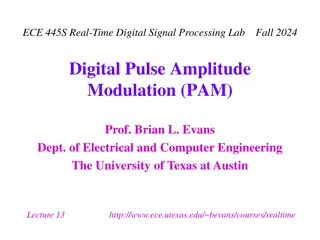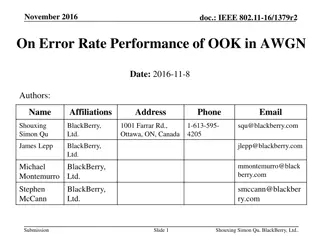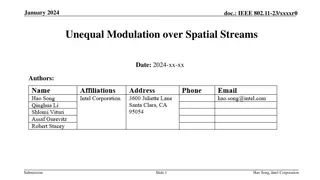Understanding Digital Modulation in Data Transmission
Delve into the world of digital modulation for data transmission, exploring various modulation schemes, digital-to-analog conversion processes, the importance of digital modulation in mixed networks, and the fundamentals of modulation and demodulation.
Download Presentation

Please find below an Image/Link to download the presentation.
The content on the website is provided AS IS for your information and personal use only. It may not be sold, licensed, or shared on other websites without obtaining consent from the author. Download presentation by click this link. If you encounter any issues during the download, it is possible that the publisher has removed the file from their server.
E N D
Presentation Transcript
(Digital Modulation Basics) Data Transmission And Digital Communication Lecture 3 2019/1440 By: Elham Sunbu
OUTLINE Digital Introduction to digital modulation Relevant modulation schemes Geometric representations Coherent & Non-Coherent Detection Modulation spectra
Digital To Analog Conversion Digital-to-analog conversion is the process of changing one of the characteristics of an analog signal based on the information in digital data. Topics discussed in this section: 1. Aspects of Digital-to-Analog Conversion 2. Amplitude Shift Keying 3. Frequency Shift Keying 4. Phase Shift Keying 5. Quadrature Amplitude Modulation
Digital-to-analog conversion Digital-to-analog conversion is the process of changing one of the characteristics of an analog signal (carrier signal) based on the information in digital data. Analog /Digital converter Digital /Analog converter
Why we need digital modulation - Digital modulation is required if digital data has to be transmitted over a medium that only allows analog transmission. - Modems in wired networks. - Wireless must use analogue sine waves. 5
7 Modulation & Demodulation Radio Channel Carrier Carrier Baseband Modulation Synchronization/ Detection/ Decision Data in Data out
Modulation Modulation : process (or result of the process) of translation the baseband message signal to bandpass (modulated carrier) signal at frequencies that are very high compared to the baseband frequencies. Demodulation is the process of extracting the baseband message back the modulated carrier. An information-bearing signal is non- deterministic, i.e. it changes in an unpredictable manner.
Why Carrier? Effective radiation of EM waves requires antenna dimensions comparable with the wavelength: Antenna for 3 kHz would be ~100 km long Antenna for 3 GHz carrier is 10 cm long Sharing the access to the telecommunication channel resources
NOTE: Bit rate, N, is the number of bits per second (bps). Baud rate is the number of signal elements per second (bauds). In the analog transmission of digital data, the signal or baud rate is less than or equal to the bit rate. S=Nx1/r bauds Where r is the number of data bits per signal element.
Example 1: An analog signal carries 4 bits per signal element. If 1000 signal elements are sent per second, find the bit rate. Solution: In this case, r = 4, S = 1000, and N is unknown. We can find the value of N from
Example 2: An analog signal has a bit rate of 8000 bps and a baud rate of 1000 baud. How many data elements are carried by each signal element? How many signal elements do we need? Solution: In this example, S = 1000, N = 8000, and r and L are unknown. We find first the value of r and then the value of L.
Modulation Process f = f (a1,a2,a3,...an,t) (= carrier) a1,a2,a3,...an(= modulation parameters) t (=time) Modulation implies varying one or more characteristics (modulation parameters a1, a2, an) of a carrier f in accordance with the information-bearing (modulating) baseband signal. Sinusoidal waves, pulse train, square wave, etc. can be used as carriers
Amplitude Shift Keying (ASK) Baseband Data 1 0 0 1 ASK modulated signal Acos( t) Acos( t) Pulse shaping can be employed to remove spectral spreading ASK demonstrates poor performance, as it is heavily affected by noise, fading, and interference
Amplitude Shift Keying (ASK) In ASK the amplitude of the carrier signal is varied to represent binary 1 or 0. Carrier signal is a high frequency signal that acts as a basis for the information signal. Both frequency and phase remain constant while the amplitude changes. The peak amplitude of the signal during each bit duration is constant, and its value depends on the bit (0 or 1). 15
Binary ASK (BASK) or On Off Keying (OOK) - Although we can have several levels of signal elements, each with a different amplitude, ASK is normally implemented using only two levels. This is referred to as binary amplitude shift keying. - In ON OFF Keying: bit 0 is represented by the absence of a carrier and bit 1 is represented by the presence of a carrier . 16
Pros and Cons - Pros: ASK transmitter and receiver are simple to design. ASK needs less bandwidth than FSK. - Cons: ASK transmission can be easily corrupted by noise. - Application: Early telephone modem (AFSK). ASK is used to transmit digital data over optical fiber. 17
Frequency Shift Keying (FSK) Baseband Data 1 0 0 1 BFSK modulated signal f0 f0 f1 f1 where f0 =Acos( c- )t and f1=Acos( c+ )t Example: The ITU-T V.21 modem standard uses FSK FSK can be expanded to a M-ary scheme, employing multiple frequencies as different states
FSK (Frequency Shift Keying) The frequency of the carrier signal is varied to represent binary 1 or 0. Both peak amplitude and phase remain constant while the frequency changes. The frequency of the signal during each bit duration is constant, and its value depends on the bit (0 or 1). 19
FSK Modulator - One way to think about binary FSK (or BFSK) is to consider two carrier frequencies Switch between two oscillators accordingly 20
ASK and FSK Amplitude Shift Keying (ASK) Very simple. Frequency Shift Keying (FSK) Needs larger bandwidth. Low bandwidth requirements. More error resilience than AM. Very susceptible to interference
Phase Shift Keying (PSK) Baseband Data 1 0 0 1 BPSK modulated signal s0 s0 s1 s1 where s0 =-Acos( ct) and s1=Acos( ct) Major drawback rapid amplitude change between symbols due to phase discontinuity, which requires infinite bandwidth. Binary Phase Shift Keying (BPSK) demonstrates better performance than ASK and BFSK BPSK can be expanded to a M-ary scheme, employing multiple phases and amplitudes as different states
Phase Shift Keying In phase shift keying, the phase of the carrier is varied to represent two or more different signal elements (Both peak amplitude and frequency remain constant). In binary PSK, we have only two signal elements: one with a phase of 0 , and the other with a phase of 180 . 23
Bandwidth of Binary PSK PSK is less susceptible to noise than ASK. PSK is superior to FSK because we do not need two carrier signals. The implementation of BPSK : the signal element with phase 180 can be seen as the complement of the signal element with phase 0 . 24
Digital Modulation Summary Amplitude Shift Keying (ASK) Frequency Shift Keying (FSK) Phase Shift Keying (PSK) Very simple. Needs larger bandwidth. More error resilience than AM. More complex. Low bandwidth requirements Robust against interference. Very susceptible to interference 25
Thank You 27







